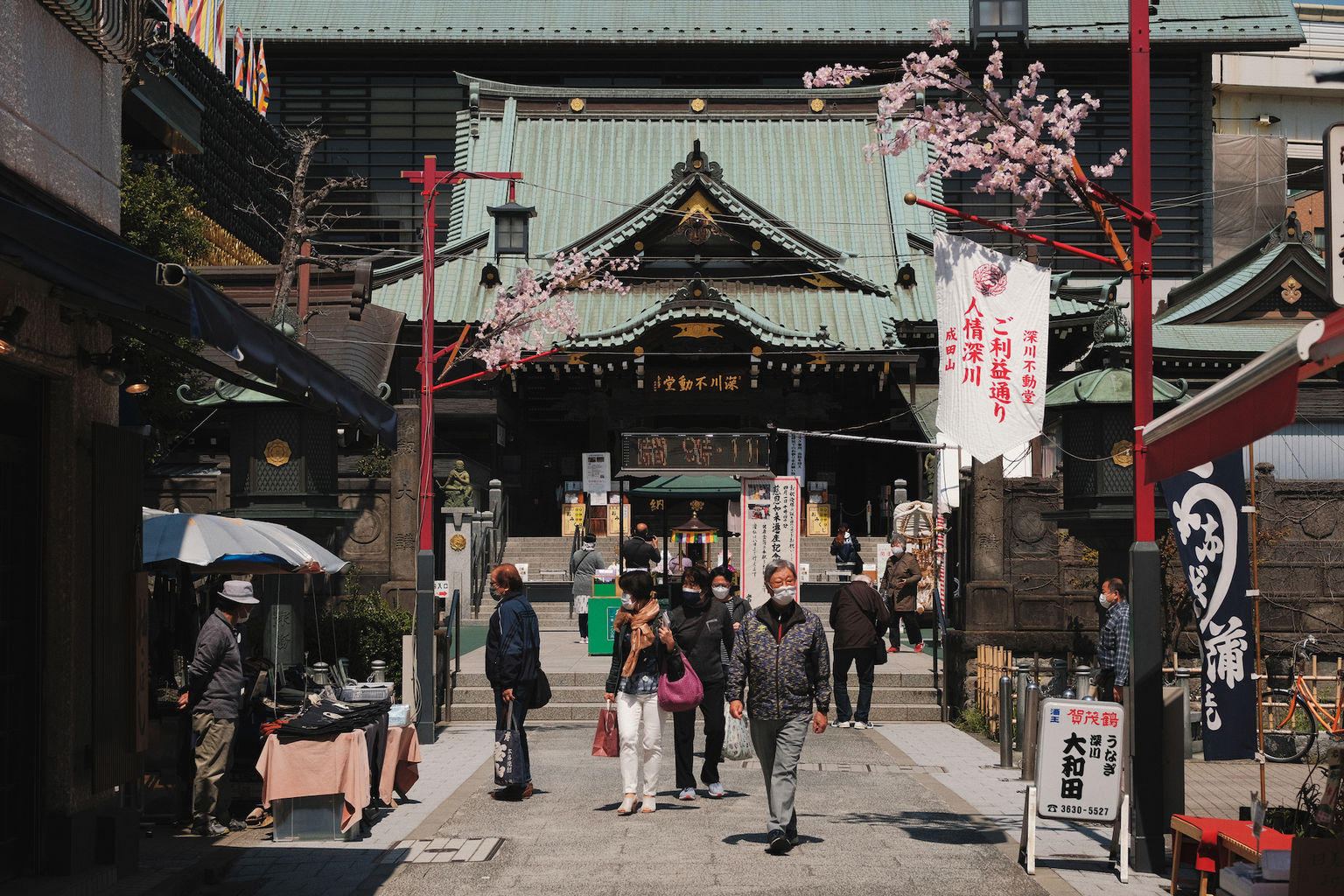From the trendy to the traditional, the vast shitamachi neighborhood of Koto Ward’s Fukagawa, is awash with independent cafés, bars, galleries and specialty shops, all enveloped in an unpretentious atmosphere.

These Streets are Made for Walking
The Fukagawa Edo Museum is a good place to familiarize yourself with the area’s extensive history. Smaller than its behemoth brother, Ryogoku’s Edo-Tokyo Museum, there’s still plenty here to get a firsthand feel of life in the Edo Era (1603–1867), including a life-size reconstruction of part of the old neighborhood which features a day to night light cycle for extra ambience. Currently closed for renovations, it will reopen with new and improved exhibits at the end of July 2022.
The museum is located along Fukagawa Shiryokan-dori Shopping Street, home to many old traditional mom-and-pop stores selling goods such as kimono, stationery, toys and various knick-knacks. If you visit in September, you’ll find the street lined with wacky-looking scarecrows dressed up for the annual kakashi contest. Other shopping districts worth checking out are the pedestrian-only Ninjo Fukagawa Goriyaku-dori, which leads up to Fukagawa Fudo-do which has a more overtly Edo Era aesthetic. Also look out for Takabashi Noraku Road, dedicated to Norakuro, the black and white cat character created by legendary manga artist Suiho Tagawa, who spent the early years of his life in the neighborhood. The street is also vehicle-free on Sundays, creating a more laid-back atmosphere.
Engineering enthusiasts will want to head down the leafy Hachiman-bori Canal and take a stroll over (or under) Hachiman Bridge. The short footbridge was Japan’s first iron bridge, constructed in 1878 and is considered a cultural asset. Kiyosu Bridge (modeled after one that spans the Rhine River in Germany) and Mannen Bridge will also be of interest — Mount Fuji was once visible from the wooden original and featured on ukiyo-e prints by renowned artists such as Katsushika Hokusai and Utagawa Hiroshige.
With a lot of ground to cover it’s a good idea to consume a hearty lunch to keep you going. Take a leaf out of an old Fukagawa fisherman’s book and opt for the local delicacy, a hearty clam and rice dish known as Fukagawa-meshi at a branch of Fukagawajuku.

In With the New
The area’s growth in popularity over the years, particularly with young artists, has fueled plenty of new hangouts in which to enjoy craft beers, quality brews and baked goods. Thankfully, many establishments have chosen to renovate rather than rebuild their properties, which helps retain the neighborhood’s shitamachi vibe. Exemplifying this approach are places such as the small second-floor gallery Ondo Stay & Exhibition and comfy coffee house Fukadaso Café, with its irregular seating and antique-laden interior adding extra authenticity.
Even established chains have followed suit. Popular Oakland-based roasters Blue Bottle Coffee has made good use of a spacious old factory for its flagship store that houses a roastery, kitchen and even the company’s offices.

Basho Bonanza
Fukagawa also has a strong association with the renowned haiku poet, Matsuo Basho, who lived in the area between 1680 and 1689. At one end of Umibe Bridge over the Sendaibori Canal is a bronze statue of the poet perched outside a small replica facade that marks the starting point of his travels in 1689, which culminated in his most famous body of work, Oku no Hosomichi. If you follow the narrow pathway along the canal you’ll find illustrated placards of his haiku lining the route.
An area further north comprises Basho Inari Shrine and the Matsuo Basho Memorial Park (an annex of the Basho Museum). The museum itself contains some artifacts from Basho’s life, but with limited English information available it’s probably only worth popping in if you’re a die-hard fan. The park, though more of a garden, has a gently elevating stone pathway leading through some lush vegetation and up to the banks of the Sumida River. Here you’ll find another small statue and a perfect place of solitude to pause and pen some personal haiku.
Alternatively, head over to Kiyosumi Gardens and be inspired by even more impressive scenery. Opened in 1880, the strolling-style garden is well worthy of its official designation as a Prefectural Place of Scenic Beauty.

Fire and Fortune
As you might expect, an area with such profound history is not without a plethora of temples and shrines to visit. Pay your respects to the enshrined Fukagawa Seven Gods of Fortune — Ebisujin at Tomioka Hachimangu (also noteworthy as the birthplace of modern sumo tournaments and focal point of the Fukagawa Hachiman Festival or “water-splashing festival”), Benzaiten at Fuyuki Bentendo, Fukurokuju at Shingyo-ji, Daikokuten at Enjuin, Bishamonten at Ryukoin, Hoteison at Fukagawa Inari Shrine and Jurojin at Fukagawa Shinmeigu — to help ward off evil and, hopefully, get your luck meter refilled.
Fukagawa Enmado is also worth stopping by to admire its mirrored main hall and talking Enma statue, as is Fukagawa Fudo-do. Its contentious contrasting architectural styles will create some debate, but for many, the main attraction ise the goma purification ritual that takes place every two hours throughout the day. Allow yourself to be hypnotized by mantra chanting and rhythmic drumming as people’s personal belongings are wafted over a small ceremonial fire, before exploring the rest of the main building and its array of intriguing antiquities.









